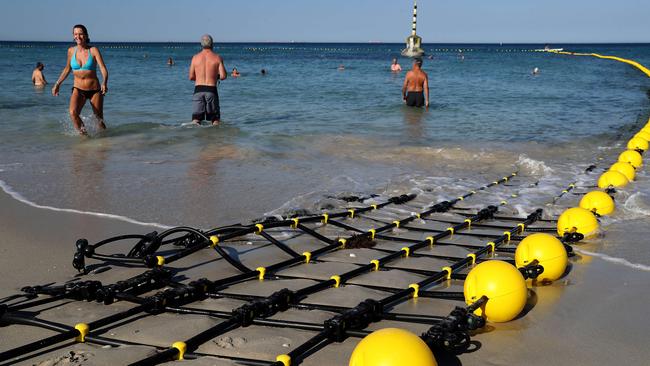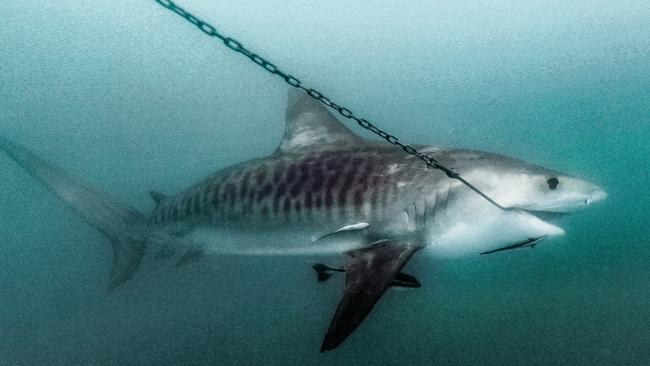Shark nets a false sense of security, say researchers
A shark has been caught off the beach where Nick Slater was fatally mauled in a suspected Great White shark attack, as alarming data reveals just how easy it is for sharks to slip inside the nets designed to protect human lives.
QLD News
Don't miss out on the headlines from QLD News. Followed categories will be added to My News.
A shark has been pulled onto a fisheries boat off the shores of a Gold Coast beach that saw a man die in an attack on Tuesday evening.
Fisheries have been scanning the water for what they believe is a 3.5m Great White shark that fatally attacked Nick Slater.
It comes after a tiger shark was found within the drumline on Wednesday.
Gold Coast shark attack: Aerial surveillance recommended, trial yet to happen
Gold Coast shark attack: Mick Fanning supports grommet surving near attack
Surf cameras capture fatal great white shark attack on Gold Coast

Meanwhile, it has been revealed that the killer shark that claimed the life of Mr Slater slipped past a defence system that uses 2km of nets to protect a 57km coastline.
The controversial shark net program, which had until Tuesday protected the Gold Coast from attacks for over 60 years, is far from the impenetrable fortress that some have long believed it to be.
In all, just 11 stretches of netting, each less than 200m long and 6m deep, are all that stand between surfers, swimmer and a shark population that fishermen and marine experts warn is booming.
The death of Mr Slater, a real estate agent, at one of the Gold Coast’s safest and most beloved beaches has again ignited the shark net debate, with critics of the program calling for an urgent overhaul to protect the lives of humans and the marine creatures caught as collateral damage by nets and baited drumlines along the coast.
There are just 27 shark nets at Queensland beaches, along with almost 400 baited drumlines.
Documentary director Andre Borell, who has recruited Hollywood star Eric Bana to narrate the soon-to-be-released Envoy Shark Cull, said it was ridiculous to continue to rely on a program installed 60 years ago.
“It’s totally unacceptable that our government continue to use safety measures from 1962 that have no scientific backing whatsoever,” he said.
He said there had been almost 30 shark attacks at Queensland beaches protected by either shark nets or drumlines.
“That’s far from successful at keeping people safe and to claim it has been a success is deceptive to the public.”
He said drone technology, which makes it easier to identify sharks in the water, and netted swimming enclosures, such as those used in calm water settings along the Gold Coast Broadwater and in North Queensland, would be more effective at protecting both humans and marine animals.

His comments were backed by shark net critic Doctor Olaf Meynecke, who has gathered more than 130,000 signatures for a change.org petition calling for the removal of shark nets during the whale migration season, which runs from June to October.
“The shark net methods are not a guarantee for safety,” he said.
He said drones, which are being trialled in different settings at beaches across the country, could report warning signs, such as the presence of large schools of bait fish believed to be in the water at the time of Tuesday’s attack.
He also called for more ‘smart’ drumlines, which allow hooked sharks to be tagged and released alive.
Bond University shark expert Daryl McPhee said ‘a perfect storm’ of scenarios had contributed to Tuesday’s attack at a beach generally regarded as one of the safest on the Gold Coast.
“It is the whale migration where there are typically more great whites around..... it was late in the afternoon....(and) there were a lot of bait fish in the water,” he said.
“The nets are not designed to be enclosures – they are not some magical barrier that separates people from sharks.
“They are designed to reduce the abundance of sharks and to disrupt a shark’s behavioural patterns so they will go somewhere else.”

Commercial fisheries in the Tweed and Gold Coast areas have reported seeing a rise in the shark populations within the last decade, including Robin Passmore of Markwell Fisheries who has heard reports ranging as far south as Newcastle.
“It’s really been a prolific rise in the past 5-10 years,” Mr Passmore said.
“It’s hard to go past the nets sometimes because of what might happen – some have just stopped it”
The sentiment was echoed earlier this year by Commercial fishing industry spokesman Michael Thompson, who claimed the Department of Fisheries “was ignoring” concerns about the shark population boom.
“They’ve created an imbalance of biodiversity by protecting… the top end of the food chain, which is the sharks, and (allowing) you to harvest the rest,” he said.
“It’s a problem for recreational fishermen, commercial fishermen, the whole lot.”
Multiple fishing charter operators along the Tweed believe the increase could be due to the growing whale population that migrate through Queensland waters each year.

